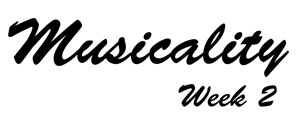Last week our West Coast Swing dancers attended their second class on musicality. This class started with a brief review of some of the main points that were discussed on week 1, such as what is a beat, a measure, and a lyrical phrase. We also reviewed the idea of Common Time and the rhythmic structure and notation of West Coast Swing. We proceeded to review our pulsed timing as an basic expression of on and off beats.
Musical Composition and the 2 Beat Extension
However, the main focus of the second class was musical composition of popular music. We listened to a "perfect" song - one that has a verse of 4 lyrical phrases and a chorus of 4 lyrical phrases. We then explored how to use 2-beat extensions during the A-part (walks), B-part (dynamic), or C-part (anchor) to extend any 6-count pattern to fit the lyrical phrase while making sure to change patterns to 8-count whips for the Chorus. This exercise trains dancers to become familiar with the 2-beat extension and also trains them to listen for the verse to chorus transitions.
2 Beat Extension Extended
As the class progressed, I introduced the idea of extending patterns by 4 or more beats. This allowed dancers to retain the integrity of basic 6-count patterns and adjust any remaining time with a longer extension to align their whips with the Chorus. Once again, this was primarily an exercise in using the extension as well as hearing verse to chorus transitions.
Musicality for Week 3
This week (the third of the series) we will continue our focus on composition and progress to counting 6-count patterns in 8s. That can sometimes be challenging for experienced dancers. Hopefully, we'll also explore accenting 1 using the syncopations that dancers learned during last month's West Coast Swing series.
Professional Development: Music and The Brain
Over the weekend I had the opportunity to attend a talk by a prominent neuroscientist on music's effects on the brain. This lecture discussed many significant topics such as: how music is processed by the brain differently than language, how music is being used medicinally, how music can make you smarter, how music can make you stronger, how music reduces stress more than silence, and more. This lecture was followed by a small concert of 4 musicians who helped illustrate the power of music.
I was so excited by this lecture and presentation that I returned home to research more studies that I could include in my Musicality presentation. I look forward to sharing this information soon.


